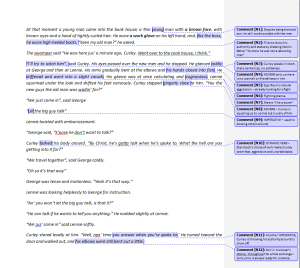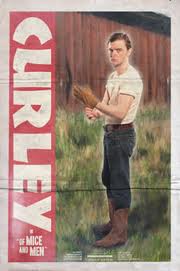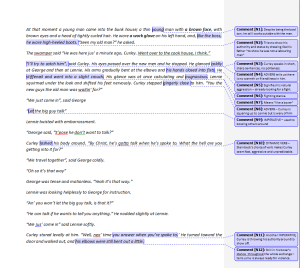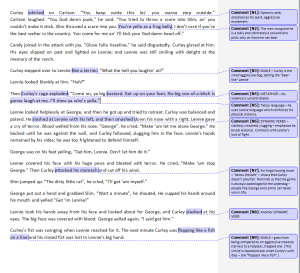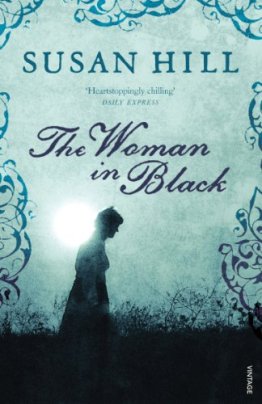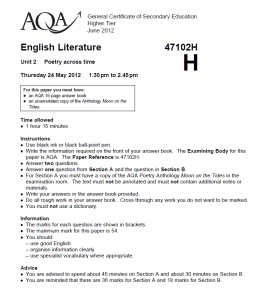Part (a) How does Steinbeck present the character of Curley in this extract? Refer closely to the passage in your answer.
Part (b) In the novel as a whole, how are violence and hostility portrayed? How do these link to the economic and social conditions of 1930s America?
Part A)
In the extract, Steinbeck uses vivid description of Curley’s physical appearance, speech, personality and the reactions of other key characters to present him as a character whom the reader immediately dislikes. Curley’s status as the boss’s son is emphasised by his clothing; he wears “high-heeled boots” as a reflection of his high status on the ranch. Steinbeck uses the phrase “tightly curled” to describe his hair, a description which aptly represents his personality too – a tightly coiled, volatile character who is always ready to spring into violent action.
Curley’s speech is blunt and direct, even to characters like George and Lennie, whom he has yet to meet. His first piece of dialogue is a direct question which requires a response from the others – “Seen my old man?” – which places him in control of the environment. He then asserts that he will try to “catch” the boss. The use of the verb “catch” here, whilst slang, implies that Curley is a predatory character, always looking to catch others out verbally and physically.
Upon encountering George and Lennie, Curley’s personality is revealed to be guarded yet simultaneously aggressive. Steinbeck uses the adverb “coldly” to suggest that he is emotionally uncaring. Curley’s aggressive stance causes Lennie to “twist with embarrassment.” As the reader has been positioned to empathise with the innocent Lennie over the last chapter, Curley’s actions towards him make him instantly dislikeable. The reader is told that Curley is a boxer, and he continually seems to carry himself in a guarded manner – the phrase “stiffened and went into a slight crouch” describes a boxer’s stance. However, it is clear that Curley guards himself not only against physical threat but also emotional connection – Steinbeck describes his glance to Lennie as “calculating and pugnacious”. Curley evidently sizes Lennie up as a potential physical threat (which links to why he steps “gingerly” towards Lennie – he is clearly wary of Lennie’s size and strength) but also subsequently alienates the other characters through his actions.
George’s attitude towards Curley is typical of that of many of the other males on the ranch – “say, what the hell’s he got on his shoulder?” Steinbeck intends for the reader, too, to perceive characters through the lens of George’s perspective, and as George judges Curley as superior and cruel, so too does the reader. This links to Candy’s assessment of Curley, who laments that he “won’t ever get canned ‘cause his old man’s the boss.” Curley’s entitlement alienates him from other characters on the ranch, so perhaps in some ways he is not dissimilar to other characters in the novel who exist as ‘loners’. However, Curley is different in that his callous personality is the cause of his own isolation.
Part B:
Curley’s callousness is emblematic of an era of American society in which life was cruel and often vicious; in the novel, this is certainly true for working class males. Whilst many male characters are aggressive and chauvinistic, some characters demonstrate more progressive attitudes. The era of violence and mistrust in 1930s America was a product of the Wall Street Crash and the Great Depression, which left many young men out of work and poverty-stricken. The resulting boom in itinerant work indirectly leads to the entitled attitudes of landowners such as the boss and his son, Curley, as well as the aggressive and isolated attitudes of the workers themselves, such as Carlson. George states that “guys like us got no family”, suggesting the isolation of many males in his and Lennie’s position. Carlson and Candy are the best examples of generational isolation – Carlson’s results in violence; he taunts Curley (“you’re as yella as a frog belly”) over his cowardice, is obsessed with his “luger” and even shoots Candy’s dog, simply because “he stinks” and is old and useless. On the other hand, Candy’s forced isolation leads to depression and weakness (“they’ll can me when they got no more use for me”). In both cases, the harshness of the characters’ society leads them to become emotionally deprived. This is emphasised by Steinbeck’s choice of the last line of the novel – “Now what do you suppose is eatin’ them two guys?” – in which he demonstrates how Carlson is so affected by society’s harshness that he cannot recognise George’s obvious emotion at having shot his best friend.
Male attitudes to sex and females are also shown to be damaging throughout the novel. Again, Curley is the prime example of this. His reaction to his wife’s death is not one of mourning, but of anger and the excitement of vengeance – “I know who done it… I’m gonna get him.” This is indicative of the chauvinistic attitudes towards women in the 1930s, who were viewed as sexual objects by men and, after marriage, as property. Indeed, Curley only ever refers to his wife in those terms, not naming her and, thus, dehumanising her. Other references to females in the novel are similarly chauvinistic. The male workers travel to “cat-houses” in town (popular during the Great Depression amongst migrant workers) to “get it all out of their system.” The fact that males simply use females as sexual gratification and as a means to stave off loneliness implies how little they are valued by males in society.
However, attitudes of characters such as George and, in particular, Slim, suggest that male attitudes can be more progressive than those defined by a cruel society. George takes care of Lennie like a brother or a father, thus demonstrating more love and care than the majority of male characters in the novel. Slim notes how “I hardly ever see guys travel together”, a statement which holds historical accuracy, mainly due to the unstable nature of itinerant work. Slim, too, is compassionate and caring towards his workers and even to the marginalised characters like Curley’s wife and Crooks. He is one of the few characters to pay Curley’s wife a compliment (“Hey, good lookin’”) and addresses Crooks not by a racial slur, but by his name. Even though Slim holds authority as the “prince of the ranch”, he has a balanced attitude towards this authority, and values kindness above aggression and violence. In many ways, the description of Slim as an old-fashioned rancher and cowboy, complete with “Stetson” and “bullwhip”, present him as the last survivor of a better time for American males, in which skills and character were valued ahead of the scramble for labour and physical dominance brought on by the Great Depression.
